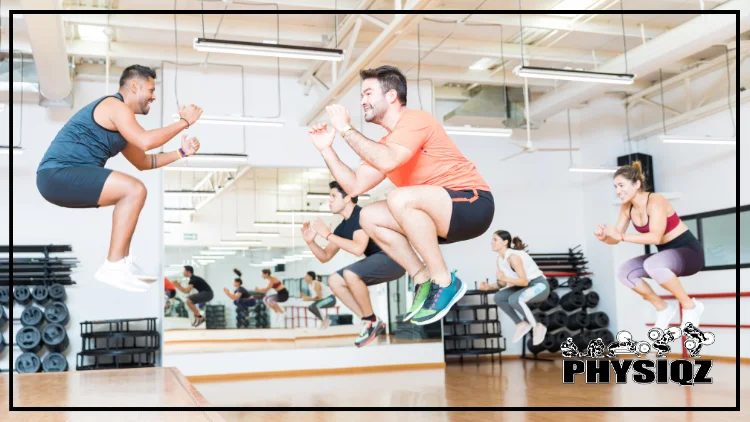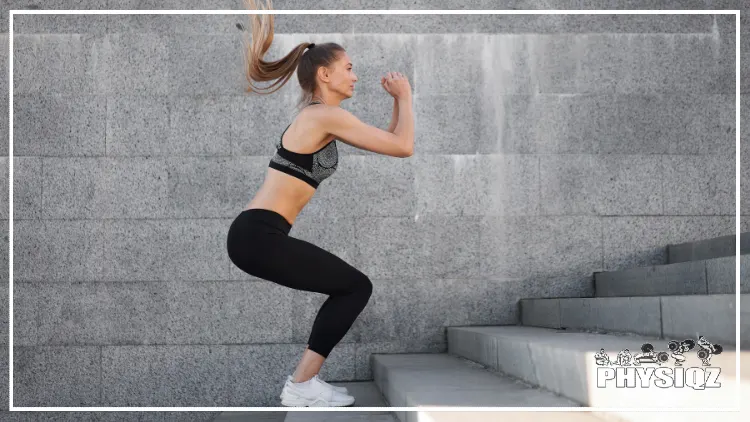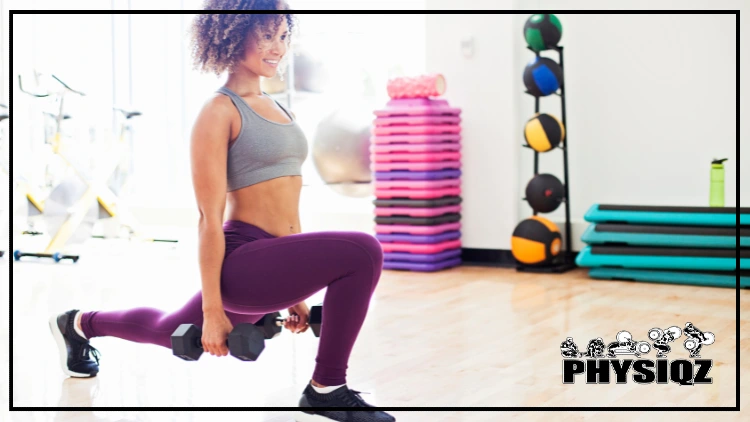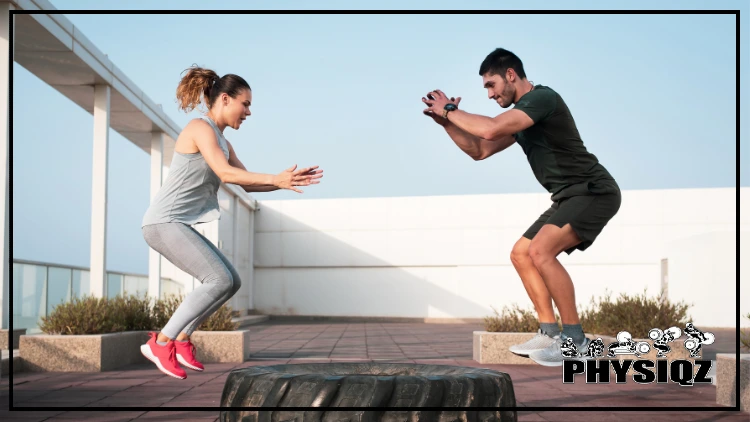
Box jumps are a great way to build muscle and improve cardio, but a box jump alternative could be a better option for people who want to work out at home, or for those with bad knees from past injuries.1
Luckily there are a number of box jump substitutes to choose from that can be integrated into any workout routine, regardless if the program is at home or for bad knees.
Readers are encouraged to utilize the list below to properly substitute plyo box jumps at home or at the gym with functional exercises that will target the same muscle groups as normal box jumps.
Best Substitute for Box Jumps (Top Alternative To Box Jumps)
Box jumps and the alternatives are the perfect exercise for both weight loss for beginners and muscle building for experts. There are countless box jump substitutions out there, but only one can be the greatest. When considering the best alternative to box jumps, squat jumps are often recommended as the top exercise.
Let’s take a look as to why it’s on top.
A squat jump is extremely similar to the box jump. In fact, the movement itself is just about the exact same as the box jump. The only difference is that a box jump or plyo box calls for jumping on top of a box, while the squat jump is just jumping as high in the air as possible.

Source: Satyrenko via Canva.com2
This makes replacing a box jump with a squat jump pretty seamless.
Because the movements for box jumping and squat jumping are so similar, the muscles being targeted during both exercises are going to be the same too. Both are great ways to engage the glutes, hamstrings, quadriceps, and calf muscles.
Much like the box jump, squat jumps significantly increase a weight lifter’s overall explosiveness. Both exercises are noted to improve neuromuscular conditioning, which helps the body move more functionally and increase overall sport performance. Furthermore, neuromuscular training is key in the prevention of injury.3
So introducing a squat jump into a workout routine has a number of added benefits and it can even be done over distance, up hills, or up stairs once the move is mastered.

Source: andriiafanasiev via Canva.com4
In fact, it is arguable that squat jumping is superior to box jumping. This is simply because while box jumping requires the use of a box jump, squat jumping can be completed with no equipment at all. This means the exercise is totally accessible to lifters.
A gym, box jump, or even weight is not required to properly engage in this movement. This makes the squat jump ideal for at home workouts, and for weight lifters who are beginners.
9 Box Jump Alternatives & How To Do Them With Proper Form
Becoming too narrow minded in the gym is one of the 8 deadly training sins. So weightlifters should keep an open mind and try any number of alternatives to box jumps listed below in order to build muscle and improve cardio and conditioning.
Exercises can be mixed and matched, as most will target similar muscle groups of the legs.
All these alternatives are great for beginners, and can be easily integrated into a 4 day workout split. Remember to check the YouTube video out for proper form demonstration!
1. Squat Jumps – The Top Plyo Box Alternative
As mentioned earlier, the squat jump stands out as the best alternative to box jumps. This box jump substitution is ideal because it doesn’t require the plyo box, or the type of box that box jumps require.
For those without the time or funds to invest in equipment, squat jumps are the most accessible and cost-effective alternative to box jumps.
The additional benefits to using a squat jump includes muscle hypertrophy or muscle building, improved conditioning, neuromuscular conditioning, functional balance and stability improvements, and cardio benefits.
Luckily, box jumps and squat jumps engage the same muscles during these exercises. This exercise is glute and hamstring focused but will also engage the quads, calves, and even core. Squat form adjustments can be used to further target different muscle groups during this exercise.
For example, using a sumo squat jump with toes abducted or facing outward can target the adductor muscles within the thigh. Or, if weights are being used during this exercise, holding the weight in front of the body rather than behind can result in greater engagement of the quadriceps.
Form
When it comes to exercise, form is everything. So let’s review the proper form required for jump squats.
Toes should be slightly pointed outwards in abduction. The slight angle in which the foot is placed sets up the entirety of the squat jump. Next, lifters should try to spread their toes as far apart as possible.
This increases the base of support of the squat, improving balance and stability.
After the feet are placed correctly, it’s time for the movement. Knees should be facing outwards to allow the hips to properly hinge downward. As this hips hinge down, the check comes out. The back should be kept in neutral flexion. This means no rounding, as well as no hyperextension.
Once the lifter is squatting with their thighs parallel to the ground, they can prepare to take an explosive movement upwards otherwise known as the jump. Squat jumpers are going to use their hands to assist in the vertical proportion in order to maximize their jump.
When landing, weight lifters should try to remain on the balls of their feet. This helps to soften the impact of landing. To help soften the impact when landing, lifters should try to land as lightly as possible.
Check out the YouTube video below to learn how to properly complete a squat jump.
Weight lifters should keep in mind that along with using proper form, it’s essential to warm up the muscles prior to working out. Warming up the targeted muscles through low grade cardio and active or passive stretching has been found to significantly improve both physical performance and injury prevention.5
So make sure to take the extra time to warm up the body for the best fitness outcomes.
2. Burpees – The Second Best Box Jump Replacement
Burpees might be everyone’s least favorite exercise. Although hard, burpees come with a number of benefits such as engaging cardio, increasing heart rate, and of course, engaging the upper and lower body muscles in compound movement.
Form
There are two phases for the burpee: The push up and the jump squat. For both phases, a lifter will start standing with the feet shoulder length apart. When engaging in the push up, the lifter will squat down and place both hands firmly on the ground in front of their feet.
They will then jump their legs backwards to assume the push up position, and will complete one rep of a full range push up. They will repeat the process to return to the standing position.
Next, from the squatting position, the lifter will jump into the air as high as they can. They should land as lightly as possible on the balls of their feet. This returns them to the starting position and is considered a single rep.
Check out this example for the ideal burpee:
3. Squats
Squats are ideal for muscle and strength building. When done with the correct form, they have the added benefit of being low in impact on the knees and hips. They are also a compound movement, which studies have shown to significantly increase muscle strength.6
Lifters wanting to maximize muscle hypertrophy should consider back squats, which allow for a heavy weight to be used during the exercise.
Form
Using good form is critical! To perform the perfect squat, simply use the same form instructions listed above under the squat jump. Instead of jumping at the end of a rep, the lifter will remain stationary at the start position before repeating the exercise.
Squat University has the best squat form video out there:
4. Step Ups
There are many benefits to using step ups instead of box jumps. First, step ups are low impact while still engaging the key muscle groups of the leg. This makes them an ideal alternative to lifters who have had knee injuries or are prone to knee pain.
Additionally, step ups can be easily upgraded using higher weights, more reps, or higher steps. They are easy to complete both at a gym, and are accessible for outdoor and at home workouts.
This exercise targets the glutes and hamstrings significantly, as well as the quadriceps muscle. Lifters can even add a single leg calf raise into the mix to engage the soleus and gastrocnemius (otherwise known as the calf) muscles.
Form
Form is critical. To complete a step up, a person will start facing the bench/stair/box/other alternative at about a foot or two away. Feet should start at roughly shoulder or hip distance apart.
Next, a lifter will place their foot on the step and engage the leg muscle group to move in an upward, vertical motion. The knee will move from an ideal 90 degrees of flexion to a full 180 degrees of extension.
The lifter will then step back down to return to their starting place, and can then switch feet to do one rep on each side. Arms should be kept at the side or placed on the hips. The core should be engaged at all times.
Check out this YouTube video for a demonstration:
5. Ankle Hops
Another great box jump alternative! This is an ideal exercise to incorporate when completing a high intensity interval training or HIIT workout. Ankle hops are a plyometric movement that will really boost explosiveness. It engaged the leg muscles, with a focus on the calf muscles.
Since the calves are perhaps the hardest muscle to grow, using calf targeting exercises are ideal for building this muscle.
Form
To properly complete an ankle hop, simply complete a small hop to complete full range of motion at the ankle joint. This can be completed on one leg or two, depending on the level of challenge desired. Stationary and dynamic movements can also be incorporated.
Here’s a video example:
6. Lunges
Lunges are great and come in a variety of forms: there’s walking lungers, reverse lunges, stationary lunges, and even pulsing lunges. Studies have even determined that walking and jumping lunges can be used to improve running speed.7
They are a perfect exercise for muscular hypertrophy while being low in impact. Finally, they engage the glutes and hamstrings significantly, with additional targeting of the quads. This is ideal for those who want to harden muscles.
Form
For the purposes of this example, let’s use a standard stationary lunge.

Source: vitapix via Canva.com8
First, start with the feet shoulder length of part. With hands on the hips, step forward and flex the knee so that it’s in approximately 90 degrees of movement. Hips should maintain a neutral position, while the ankles are engaged in dorsiflexion.
A dorsiflexed foot will help maintain stability.
Next, the lifter will return to their starting position. This is done by an explosive leg movement to go from lunging to standing again. The same will be repeated on the opposite leg.
Here’s an example of good lunging form:
7. Tuck Jump
This exercise is ideal for those wanting to improve their cardio and overall explosiveness. Tuck jumps have the additional benefit of engaging the key leg muscle groups, as well as improves body coordination and movement control. Use with a deadlift workout to target hamstrings and explosiveness.
Form
Start at a standing position with feet shoulder length of part. From here, a lifter should bend the knees and use an explosive movement to maximize their vertical jump. During this jump, knees should be brought as high as possible, tucking into the body to form a ball.
Upon coming back down from the jump, the knees will extend again. Make sure full extension is not used. This can cause a lot of stress on the knee joint and cause injury. When landing, remember to land softly and on the balls of the feet.
Here’s a form example:
8. Weighted Vest Jumps
Weighted vest jumps involve the same muscles as box jumps and jump squats. However, this has the added benefit of increasing the load through adding more weight. This improvement in load is ideal for lifters wanting to maximize their strength and muscle growth.
Form
Simply use the same form detailed above for squat jumps.
9. Jump Rope
Jump rope engages the muscles required for jumping, including the glutes, hamstrings, and quads. It also significantly targets the muscles of the calf. This is a great alternative to aid in the improvement of overall explosiveness and vertical performance.
Additionally, jump rope can make for good cardio. Depending on the length and intensity, it can be both a HIIT and aerobic workout. Jump rope can even be used as a warm up for squat and deadlift same day workouts.
Finally, studies have shown that jumping rope can improve running speed, jumping ability, and even foot and ankle stiffness.9
Form
Jump rope form can vary depending on the needs of the workout. Jumps can be rapid and involve dynamic movement such as diagonal patterns. Or it can be slowed down with high jumps along the vertical plane to maximize the engagement of the muscles in the thigh.
As a general rule, feet should remain shoulder length apart. Both the knees and ankle should be engaged in slight flexion and extend with the jump movement.
Make sure to land lightly on the balls of the feet to decrease the amount of impact on the involved joints.
And of course, be ready to jump again!
Here’s an example of good form for jumping rope:
Possibility of Doing Box Jumps Without a Box
Lifters can still simulate a box jump exercise without an actual box, but it’s not quite the same. Technically, if a box jump is done without a box, then the exercise isn’t a box jump at all.
That being said, there are alternative exercises to box jumps that can be done without the need for a plyo box. Check out the list above for the best box jump substitutes, or the list below for ideas of what to use instead of a box.
Using the exercises on this list is perfect for those wanting to complete an at home workout, or who just simply want to be able to workout outdoors.
What To Use for Box Jumps at Home (At Home Box Jump Alternatives)
Before reviewing alternatives to the plyo box, it’s important to note that these items were not designed to be jumped on. Plyo boxes are built specifically for box jumps, and are therefore crafted for safety. They typically do not tip over, can support a substantial amount of body weight, and are ideal to use when available.
Alternative items for box jumps may be less stable because they have a different functional design. But that being said, there are still a number of relatively safe options for those who want to complete box jumps outside of the gym.
For at home box jumps, furniture is the best way to go. Lifters can use couches, stable chairs, benches, or even their bed to engage in box jumps without the actual box. Stairs are another great option for those wanting to box jump without the supplies, as they are stable.
But make sure to complete the exercise closest to the bottom just in case a fall does happen. Weight lifters can even visit their local park to use park benches as a box jump substitution.
At-home workouts are ideal for health enthusiasts who don’t have a current gym membership or who don’t have the time to drive to their local gym. However, rather than opting for alternatives to box jumps at home, lifters may find themselves more motivated and engaged when working out at a local park.
In fact, research suggests that those engaging in workouts while outdoors experience a significantly higher workout satisfaction and overall enjoyment.10 So if the weather is nice, make sure to get out of the house and workout outside.
Box Jump Modification To Make Them Easier
There are a few key strategies for box jump modification to downgrade the challenge and make the exercise a little bit easier.
For example, lowering the height used during a box jump can significantly help with lifters who are struggling to complete sets of higher box jumps. Another good technique to use to modify box jumps is to complete step ups instead. This will engage the same muscles that use box jumps, but requires less explosiveness.
Finally, jumping on ground markers can be an easy modification. This is especially ideal if a person has difficulty with balance and stability, or has trouble with vertical jumping.
To increase the challenge and up the cardio aspect of this exercise, a person can rapidly jump back and forth for a short period of time with few rest breaks. This can turn jumping into a high intensity interval training, or HIIT workout session.
Box Jump Alternatives for Bad Knees (Low Impact Alternatives)
It’s no secret that box jumps can be really hard on the knees. This limits what a person with a previous knee injury can do during a workout, and even increases the risk of injury due to high impact.
Lifters looking for a knee-friendly alternative to box jumps can choose these substitutions for a low-impact workout that targets the legs. Some lifters might still have knee pain, even if a workout is low impact.
Those with knee issues are encouraged to use exercises to strengthen and stretch for treating knee pain. This should help improve pain as well as joint stability and strength.
There are numerous low-impact alternatives to box jumps available. For example, completing squat jumps in a pool will take the pressure off the knees while still engaging the muscles involved in box jumps. Exercises such as lunges, step ups, and squats will also target key leg muscle groups without impacting the knees.
Getting cardio with knee pain is extremely difficult. Luckily, there are low impact cardio techniques to use that are fun too! Readers with bad knees should explore cycling, rowing, and swimming to exercise the heart without the added joint stress.
Box Jump Workout Plan Using Alternatives That Promote Explosiveness
Lifters wanting to maximize their explosiveness should utilize this box jump workout plan. This regime requires three days a week of hard work and gradual but progressive overloading. Studies show that slowly increasing the load or reps of an exercise can maximize muscle strength.11
Lifters should aim to increase the amount of sets, reps, and/or weight each session by a manageable amount to maximize muscular hypertrophy.

Source: Stefan Tomic via Canva.com12
This explosiveness routine can easily be integrated with a 6 week powerlifting program to improve speed, velocity, and muscular hypertrophy. The program below is in a Sets x Reps format. So 4×15 means you’ll do four sets, and in each set, 15 reps should be done.
Day 1
4 x 15 of the following:
- Box Jumps
- Leg Curls
- Squat Jumps
- Leg Extensions
Day 2
4 x 12 of the following:
- Burpee Box Jumps
- Squats
- X100 Reps Jump Rope
- Step Ups
Day 3
4 x12 of the following:
- Box Jumps
- Glute Kickbacks
- Burpee Squat Jumps
- Jump Rope (4×100)
Readers now know that there are a ton of feasible workout substitutions for the plyo box jumps at home. Lifters should make sure to try a box jump alternative, or mix and match from the substitutions above to create the ultimate box jump workout.
References
1Trainer Doing Tuck Jumps With Clients In Health Club – Photos by Canva. (n.d.). Canva. Retrieved April 19, 2023, from <https://www.canva.com/photos/MADaEvCI7qQ-trainer-doing-tuck-jumps-with-clients-in-health-club/>
2https://www.canva.com/photos/MADaEvCI7qQ-trainer-doing-tuck-jumps-with-clients-in-health-club/ <https://www.canva.com/photos/MAD-G0dA8BU>
3Etty Griffin L. Y. (2003). Neuromuscular training and injury prevention in sports. Clinical orthopaedics and related research, (409), 53–60. <https://doi.org/10.1097/01.blo.0000057788.10364.aa>
4Female Athlete Doing Squat Jumps on Urban Stairs – Photos by Canva. (n.d.). Canva. Retrieved April 19, 2023, from <https://www.canva.com/photos/MAENuncGVmA-female-athlete-doing-squat-jumps-on-urban-stairs/>
5Fradkin, A. J., Zazryn, T. R., & Smoliga, J. M. (2010). Effects of warming-up on physical performance: a systematic review with meta-analysis. Journal of strength and conditioning research, 24(1), 140–148. <https://doi.org/10.1519/JSC.0b013e3181c643a0>
6Paoli, A., Gentil, P., Moro, T., Marcolin, G., & Bianco, A. (2017). Resistance Training with Single vs. Multi-joint Exercises at Equal Total Load Volume: Effects on Body Composition, Cardiorespiratory Fitness, and Muscle Strength. Frontiers in physiology, 8, 1105. <https://doi.org/10.3389/fphys.2017.01105>
7Jönhagen, S., Ackermann, P., & Saartok, T. (2009). Forward lunge: a training study of eccentric exercises of the lower limbs. Journal of strength and conditioning research, 23(3), 972–978. <https://doi.org/10.1519/JSC.0b013e3181a00d98>
8Lunges – Photos by Canva. (n.d.). Canva. Retrieved April 19, 2023, from <https://www.canva.com/photos/MAEJRr7Pyl0-lunges/>
9García-Pinillos, F., Lago-Fuentes, C., Latorre-Román, P. A., Pantoja-Vallejo, A., & Ramirez-Campillo, R. (2020). Jump-Rope Training: Improved 3-km Time-Trial Performance in Endurance Runners via Enhanced Lower-Limb Reactivity and Foot-Arch Stiffness. International journal of sports physiology and performance, 1–7. Advance online publication. <https://doi.org/10.1123/ijspp.2019-0529>
10Thompson Coon, J., Boddy, K., Stein, K., Whear, R., Barton, J., & Depledge, M. H. (2011). Does participating in physical activity in outdoor natural environments have a greater effect on physical and mental wellbeing than physical activity indoors? A systematic review. Environmental science & technology, 45(5), 1761–1772. <https://doi.org/10.1021/es102947t>
11Plotkin, D., Coleman, M., Van Every, D., Maldonado, J., Oberlin, D., Israetel, M., Feather, J., Alto, A., Vigotsky, A. D., & Schoenfeld, B. J. (2022). Progressive overload without progressing load? The effects of load or repetition progression on muscular adaptations. PeerJ, 10, e14142. <https://doi.org/10.7717/peerj.14142>
12Couple doing tire squat jumps outdoors active workout – Photos by Canva. (n.d.). Canva. Retrieved April 19, 2023, from <https://www.canva.com/photos/MAEJeXUZ4zA>